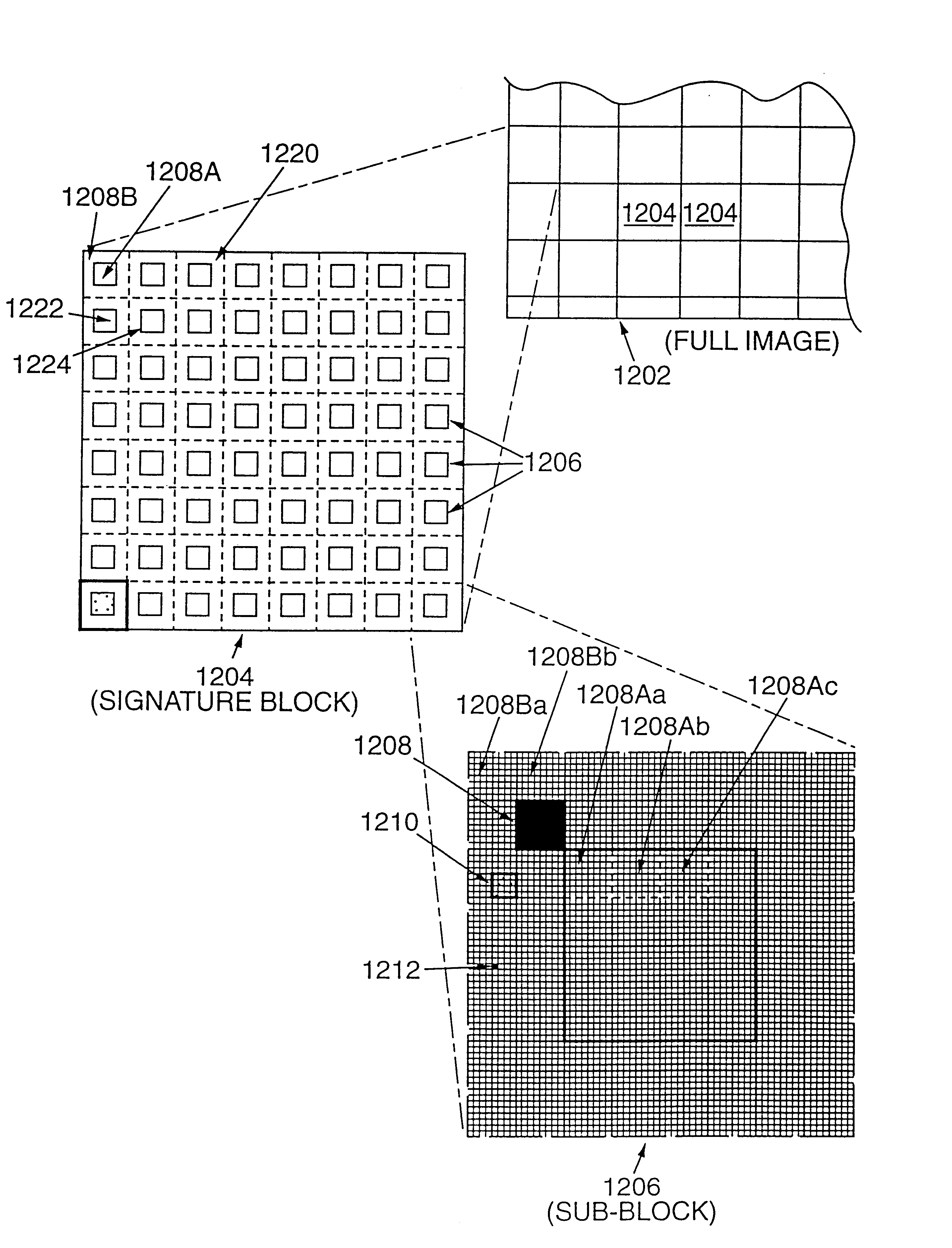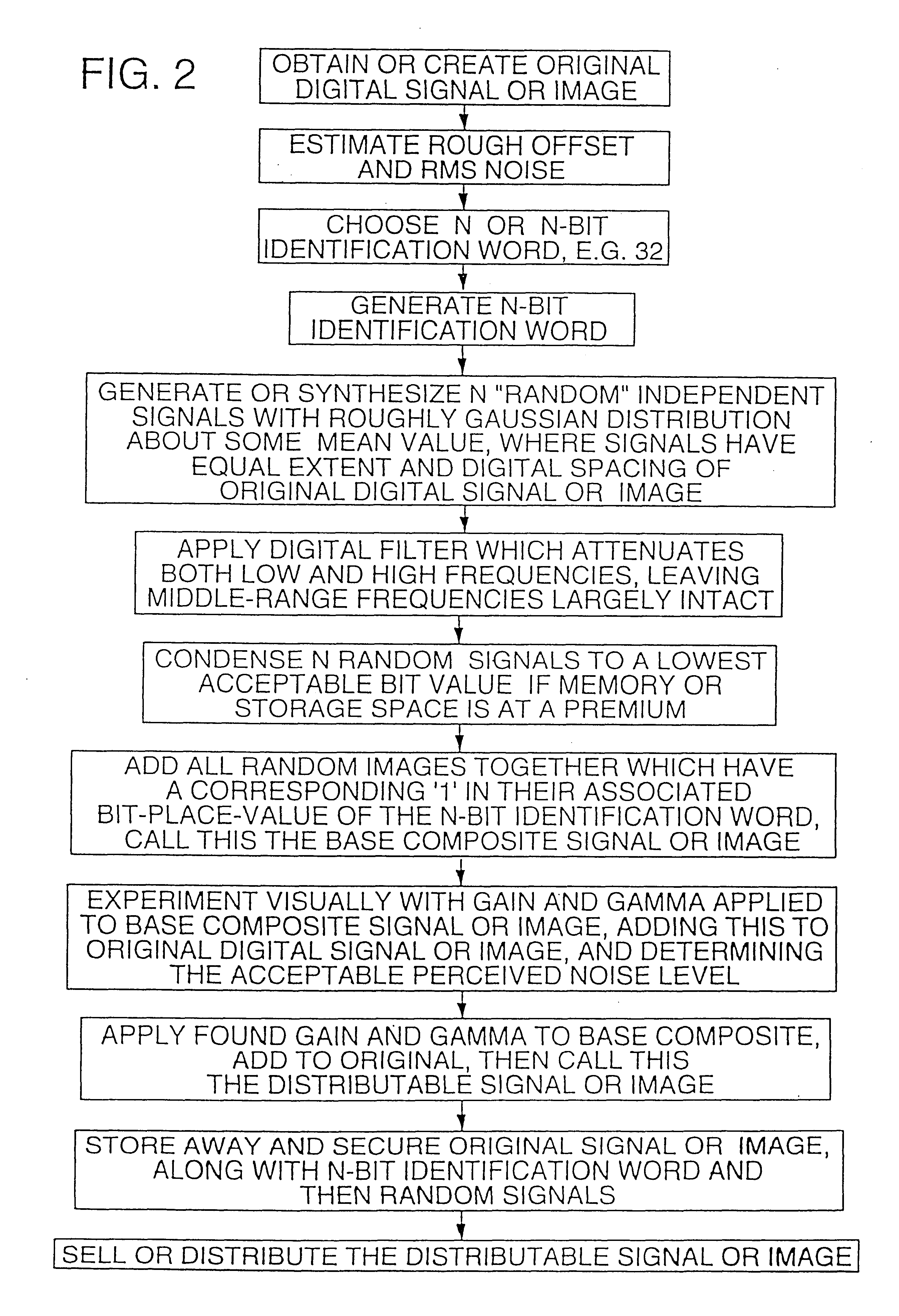Tile-based digital watermarking techniques
a technology of digital watermarking and tiles, applied in image data processing details, special data processing applications, record information storage, etc., can solve problems such as difficult follow-up of work
- Summary
- Abstract
- Description
- Claims
- Application Information
AI Technical Summary
Problems solved by technology
Method used
Image
Examples
first embodiment
The detailed methodology of this first embodiment begins by stating that the N-bit identification word is encoded onto the original signal by having each of the m bit values multiply their corresponding individual embedded code signals, the resultant being accumulated in the composite signal, the fully summed composite signal then being attenuated down to the acceptable perceived noise amplitude, and the resultant composite signal added to the original to become the distributable signal.
The original signal, the N-bit identification word, and all N individual embedded code signals are then stored away in a secured place. A suspect signal is then found. This signal may have undergone multiple copies, compressions and decompressions, resamplings onto different spaced digital signals, transfers from digital to analog back to digital media, or any combination of these items. IF the signal still appears similar to the original, i.e. its innate quality is not thoroughly destroyed by all of...
specific example
Imagine that we have taken a valuable picture of two heads of state at a cocktail party, pictures which are sure to earn some reasonable fee in the commercial market. We desire to sell this picture and ensure that it is not used in an unauthorized or uncompensated manner. This and the following steps are summarized in FIG. 2.
Assume the picture is transformed into a positive color print. We first scan this into a digitized form via a normal high quality black and white scanner with a typical photometric spectral response curve. (It is possible to get better ultimate signal to noise ratios by scanning in each of the three primary colors of the color image, but this nuance is not central to describing the basic process.) Let us assume that the scanned image now becomes a 4000 by 4000 pixel monochrome digital image with a grey scale accuracy defined by 12-bit grey values or 4096 allowed levels. We will call this the “original digital image” realizing that this is the same as our “origin...
second embodiment
In this second embodiment, the PRN data used for encoding and decoding can be as simple or complex as desired. A simple system may use the same PRN data for each call. Such data may be generated, e.g., by a deterministic PRN generator seeded with fixed data unique to the telephone and known also by the central station (e.g. a telephone identifier), or a universal noise sequence can be used (i.e. the same noise sequence can be used for all telephones). Or the pseudo random data can be generated by a deterministic PRN generator seeded with data that changes from call to call (e.g. based on data transmitted during call set-up identifying, e.g., the destination telephone number, etc.). Some embodiments may seed the pseudo random number generator with data from a preceding call (since this data is necessarily known to the telephone and the carrier, but is likely not known to pirates).
Naturally, elements from the foregoing two approaches can be combined in various ways, and supplemented b...
PUM
 Login to View More
Login to View More Abstract
Description
Claims
Application Information
 Login to View More
Login to View More - R&D
- Intellectual Property
- Life Sciences
- Materials
- Tech Scout
- Unparalleled Data Quality
- Higher Quality Content
- 60% Fewer Hallucinations
Browse by: Latest US Patents, China's latest patents, Technical Efficacy Thesaurus, Application Domain, Technology Topic, Popular Technical Reports.
© 2025 PatSnap. All rights reserved.Legal|Privacy policy|Modern Slavery Act Transparency Statement|Sitemap|About US| Contact US: help@patsnap.com



